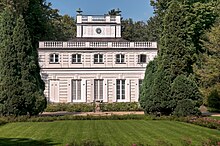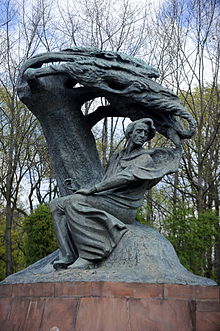Łazienki Park
The Łazienki Park (German: Park of Baths ) is the largest park in Warsaw with 80 hectares . The park is located in the Śródmieście district on the Aleje Ujazdowskie , the southern part of the Warsaw Royal Route , which leads from the Royal Castle to Wilanów . In the north, the park merges with Ujazdowski Park , which is located on the other side of Agrykola.
history
The gardens were built in the 17th century by Tylman van Gameren in the Baroque style for the owner of Ujazdów Stanisław Lubomirski . The park was named after a bathing pavilion that was built at that time. In 1764, the year he was elected King of Poland, Stanisław August Poniatowski acquired the palace gardens. The creation of the new classical garden became the life's work of Stanisław II August. The park was created by Dominik Merlini , Johann Christian Kamsetzer and the garden architect Johann Christian Schuch . The most important buildings are designed around the Łazienki Lake and River, such as the Palace on the Water, the Theater on the Island and the Sobieski Monument.
Most of the buildings were burned down by the German Wehrmacht after the Warsaw Uprising in 1944. Compared to the old town, however, the building structure remained relatively well preserved, so that the reconstruction could be completed in the first post-war years.
Łazienki Palace
The Łazienki Palace (Polish: Pałac Łazienkowski or Pałac na Wodzie ), also called Palace on the Water or Palace on the Island, was built in the 17th century by Tylman van Gameren for Stanislaus Lubomirski. From 1772 to 1793 Dominik Merlini rebuilt the castle for Stanislaus August Poniatowski , who made it his residence. The interior of the bathing establishment was designed in the Chinese style, which was very popular in the classicism era. The castle is located on an artificial island on Lake Łazienki, which is connected to the mainland by two arcaded bridges.
The palace was sacked by the German Wehrmacht after the Warsaw Uprising in 1944 and rebuilt after the Second World War.
Theater on the island
The theater on the island (Polish Teatr na Wyspie ) was built in 1790 by Jan Chrystian Kamsetzer on the site of an older theater on an artificial island in the southern Łazienki Lake, modeled on the ancient theater of Herkulaneum . The stage, equipped with ancient ruins and statues, is located on the water and is separated from the classical round theater, which is embedded in the green of the park, by Lake Łazienki.
Belvedere
The Belvedere Palace (Polish Belweder ) from 1660 is located on a hill on the western edge of the park. It was rebuilt by Jakub Kubicki in the classical style after 1767. From 1817 to 1830 it served as the private palace of the Russian governor, Grand Duke Konstantin Pavlovich Romanov , the tsar's brother. The insurgents of the November Uprising stormed it on the evening of November 29, 1830, coming from the ensign school, also located in Łazienki Park. Konstantin Romanov managed to escape, but this triggered the uprising that lasted over a year. The palace became the model for many Polish small nobility palaces. In the interwar period and from 1989 to 1994, it served as the official residence of the Polish President .
White House
The White House (Polish: Biały Domek ), built from 1774 to 1776, was intended for the lover of King Stanislaus II August Elżbieta Grabowska . It was one of the first buildings completed by Dominik Merlini in Łazienki Park. It is located on the royal road from Ujazdowski avenues to the Palace on the Water . The White House has a square footprint. The interior was decorated with frescoes by Jan Bogumił Plersch and Jan Ścisło . Louis XVIII lived here during his exile . Although the White House was partially burned down by the German Wehrmacht after the Warsaw Uprising , it remained one of the best-preserved buildings in Łazienki Park. The interior has largely been preserved in its original state from the time of Stanislaus August Poniatowski .
Old orangery
The Old Orangery (Polish: Stara Pomarańczarnia ) was built from 1786 to 1788 by Dominik Merlini in the form of a horseshoe in the north-western part of the park in order to overwinter the southern flora of the park - especially orange trees - and to provide accommodation for the gardeners. Today in the wings of the Old Orangery you can find the 18th century court theater with frescoes by Jan Bogumił Plersch and the largest gallery of Polish sculpture from the 16th to the 20th century with over 700 exhibits.
New orangery
The New Orangery ( Nowa Pomarańczarnia in Polish ) dates back to 1860 and was built by Adam Adolf Loeve and Józef Orłowski . The glass building in Victorian style has an imposing hall in which a variety of tropical and southern plants thrive. The New Orangery is on Wilanów Way , also known as the Chinese Way .
Old Kordegarda
The Old Kordegarda (Polish Stara Kordegarda , fr. Corps de gardes = main guard) was built by Johann Christian Kamsetzer from 1791 to 1792 on the eastern edge of the northern Łazienki Lake. The front side occupies a row of columns, which is crowned by a classical attic.
New Kordegarda
The New Kordegarda (Polish Nowa Kordegarda ) is located in the immediate vicinity of the palace on the water west of the Łazienki Lake. It was built by Domenico Merlini from 1779 to 1780 and the interior was designed by Jan Bogumił Plersch. In 1830 Jakub Kubicki carried out a renovation of the facade, due to which the Kordegarda is called the new one.
Myślewicki Palace
The early classical Myślewicki Palace (Polish: Pałac Myślewicki ) owes its name to the village of Myślewice. The palace was built in three phases by Merlini from 1775 to 1779 on behalf of King Stanislaus August. The building, initially built on a square floor plan, was supplemented by two round wings. Inside, the original decoration of the dining room with views of Rome and Venice and the bathroom designed by the painter Jan Bogumił Plersch have been preserved. Originally intended for members of the royal court, it later passed to Józef Poniatowski, whose initials were incorporated into a cartouche above the entrance.
Diana temple
The classical Diana Temple (also Sybillentempel , Polish Świątynia Sybilli ) was built in 1822 on the northwestern oxbow of the southern Łazienki Lake according to plans by Jakub Kubicki based on the Ionian order of ancient Greek architecture. The building gives a massive impression, but was made of wood. Inside there are wall paintings with flower and fruit motifs.
Egyptian temple
The Egyptian Temple (Polish Świątynia Egipska ) was built in 1822 by Jakub Kubicki at the end of the southwestern oxbow arm of the southern Łazienki Lake. Before that, there was Stanisław Lubomirski's fortification, which protected Warsaw from the south. A bridge was erected here in 1771. After the destruction by the German Wehrmacht in 1944, only the northern part of the temple remained. The southern temple complex was not rebuilt after the war.
Great Officers (Ensign School)
The kitchen and service building of the facility, created by Tylman van Gameren on the eastern bank of the northern Łazienki Lake , has been located here since the 17th century . In 1778 the building was rebuilt by Merlini and given a column portal. In 1788 a south wing was added. Until 1831 the building served as an ensign school (Polish Podchorążówka ), from which on November 29, 1830 the November Uprising started.
Water tower
The water tower is near the old orangery. It was designed in 1827 by Chrystian Piotr Aigner based on the model of the Roman tomb of Caecilia Metella on the Via Appia to supply the palaces and fountains in the park with water. Today it mainly serves changing art exhibitions.
Monuments
Fryderyk Chopin Monument
The monument to Fryderyk Chopin ( Frédéric Chopin in French ) was created in 1908 by Wacław Szymanowski in honor of the composer and pianist who was born in Żelazowa Wola near Warsaw . The monumental Jugendstildenkmal was not erected until 1926.
It depicts Chopin under a Mazovian willow bent by the wind . The monument was destroyed and melted down at the beginning of the German occupation in World War II. In 1958 it was reconstructed again. Today, piano concerts are often held on Sundays under the monument around Lake Chopin, and are open to all visitors to the Łazienki Park.
Jan Sobieski monument
The monument to Johann III. Sobieski was erected on September 14, 1788 on the 105th anniversary of the relief of Vienna on the bridge (Agricola) over the northern Łazienki Lake, at the instigation of King Stanislaus August. André Le Brun was responsible for the project carried out by Franciszek Pinck . King Jan III Sobieski is depicted on horseback with a defeated ottoman underneath. On November 29, 1830, the insurgents from the Ensign School gathered under the memorial before storming the Belvedere to drive the Russian governor out.
Henryk Sienkiewicz Monument
The monument was created by the sculptor Gustaw Zemła as the Janina and Zbigniew Porczyńskis Foundation and unveiled on May 5, 2000 in honor of the Nobel Prize winner Henryk Sienkiewicz .
Józef Piłsudski monument
The Piłsudski monument was erected south of the Chopin monument in 1998 based on a design by Stanisław Ostrowski . Józef Piłsudski , who later became Marshal of Poland, set up the Polish legions in Austria-Hungary during the First World War , which were the guarantors for regaining independence. During the Polish-Soviet War he succeeded in stopping the Red Army on the Vistula in 1920 and repulsing it ( miracle on the Vistula ).
Web links
Coordinates: 52 ° 12 ′ 46 ″ N , 21 ° 1 ′ 58 ″ E















